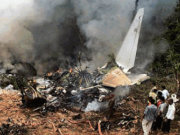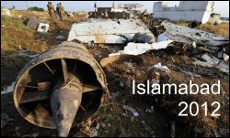A simple change in flight operations could easily prevent many "crew-caused" approach accidents, runway excursions and loss of control events. Misunderstandings and lack of knowledge result in it being ignored.
| Recently published landing accident reports | |
|
|
Air Canada, Halifax March 2015 Night non-precision approach in snowstorm |
|
|
Asiana Airlines Hiroshima April 2015 Night non-precision approach in fog |
|
|
Turkish Airlines Kathmandu March 2015 Day non-precision approach in fog |
Every year, so-called "Pilot error" results in deaths, injuries and damaged aircraft.
In such approach and landing accidents, the pilots were often under-prepared, misinterpreted information, or did not cross-check each other effectively.
"Monitored approach" crew procedures are the simplest and most cost-effective way to address the human factors problem areas that lead to most "crew-caused" approach and landing events.
- transition from instrument to visual reference, often resulting in the aircraft continuing below Decision Height without adequate guidance.
- overall management of approach and go-around, leading to excessive pilot workload and poor resource management
- effectiveness of cross-cockpit monitoring, where the pilot monitoring has not prevented the pilot flying from continuing an unsafe flight path.
Most "crew-caused" accidents involve at least one of these factors, and many involve all three. The solution is in the hands of the Flight Operations community - the pilots themselves.
It's up to pilots themselves to act.
 Public perceptions that pilots are now the biggest threat to their safety must be acknowledged.
Public perceptions that pilots are now the biggest threat to their safety must be acknowledged.
Facts, figures and data.
 Accident reports show that ordinary human limitations in crew behaviour remain a major problem.
Accident reports show that ordinary human limitations in crew behaviour remain a major problem.
"Culture" at all levels.
 "Pilot culture" is a huge factor affecting safety that CRM training still hasn't adequately addressed.
"Pilot culture" is a huge factor affecting safety that CRM training still hasn't adequately addressed.
Rank, role & function.
 "Pilot & co-pilot?" "Pilot Flying & Pilot Monitoring?" "Captain & Copilot?" "Captain & First Officer?"
"Pilot & co-pilot?" "Pilot Flying & Pilot Monitoring?" "Captain & Copilot?" "Captain & First Officer?"
Usage and experience.
 Pilots familiar with these procedures strongly endorse the many safety benefits.
Pilots familiar with these procedures strongly endorse the many safety benefits.
"First Officers' Sectors"
 "Leg and leg" flying is not diminished by PicMA. "F/O sectors" are not as simple as is often assumed.
"Leg and leg" flying is not diminished by PicMA. "F/O sectors" are not as simple as is often assumed.
Where did they go wrong?
 A fictional accident, but most experienced pilots will recognise how easily it could happen to anyone.
A fictional accident, but most experienced pilots will recognise how easily it could happen to anyone.
Implementing PicMA.
 Minimal changes and training are needed to start safer operations on an everyday basis.
Minimal changes and training are needed to start safer operations on an everyday basis.
Criticisms, objections and rebuttals.
Pilots resist using these procedures for reasons that usually turn out to be based on misunderstandings and emotion, not facts and analysis. Read more....





